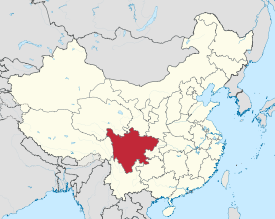Szechwan
|
Sichuan Province 四川省 |
|
|---|---|
| Province | |
| Name transcription(s) | |
| • Chinese | 四川省 (Sìchuān Shěng) |
| • Abbreviation |
or (pinyin: Chuān or Shǔ Sichuanese: Cuan1 or Su2) |
| • Sichuanese | Si4cuan1 Sen3 |
 Map showing the location of Sichuan Province |
|
| Coordinates: 30°08′N 102°56′E / 30.133°N 102.933°ECoordinates: 30°08′N 102°56′E / 30.133°N 102.933°E | |
| Named for | Short for 川峡四路 chuānxiá sìlù literally "The Four Circuits of the Rivers and Gorges", referring to the four circuits during the Song dynasty |
| Capital (and largest city) |
Chengdu |
| Divisions | 21 prefectures, 181 counties, 5011 townships |
| Government | |
| • Secretary | Wang Dongming |
| • Governor | Yin Li |
| Area | |
| • Total | 485,000 km2 (187,000 sq mi) |
| Area rank | 5th |
| Population (2013) | |
| • Total | 81,100,000 |
| • Rank | 4th |
| • Density | 170/km2 (430/sq mi) |
| • Density rank | 22nd |
| Demographics | |
| • Ethnic composition |
Han - 95% Yi - 2.6% Tibetan - 1.5% Qiang - 0.4% |
| • Languages and dialects | Southwestern Mandarin (Sichuanese Mandarin), Khams Tibetan |
| ISO 3166 code | CN-51 |
| Vehicle registration | 川A-Z |
| GDP (2016) |
CNY 3.27 trillion USD 492.01 billion (9th) |
| • per capita |
CNY 39,835 USD 5,999 (25th) |
| HDI (2014) | 0.720 (high) (23rd) |
| Website | www |
| Sichuan | |||||||||||||||||||||||||||||||||||||||||
|
"Sichuan" in Chinese characters
|
|||||||||||||||||||||||||||||||||||||||||
| Chinese | |||||||||||||||||||||||||||||||||||||||||
|---|---|---|---|---|---|---|---|---|---|---|---|---|---|---|---|---|---|---|---|---|---|---|---|---|---|---|---|---|---|---|---|---|---|---|---|---|---|---|---|---|---|
| Postal | Szechwan | ||||||||||||||||||||||||||||||||||||||||
| Literal meaning | "Four River [Circuits]" | ||||||||||||||||||||||||||||||||||||||||
|
|||||||||||||||||||||||||||||||||||||||||
| Transcriptions | |
|---|---|
| Standard Mandarin | |
| Hanyu Pinyin | Sìchuān |
| Bopomofo | ㄙˋ ㄔㄨㄢ |
| Gwoyeu Romatzyh | Syhchuan |
| Wade–Giles | Ssŭ4-chʻuan1 |
| IPA | [sɨ̂.ʈʂʰwán] |
| other Mandarin | |
| Sichuanese Pinyin | Si4-cuan1 |
| Wu | |
| Romanization | Sy3-tshoe1 |
| Hakka | |
| Romanization | Si-tshôn |
| Yue: Cantonese | |
| Yale Romanization | Sei-chyūn |
| IPA | [sēi̯.tsʰýːn] |
| Jyutping | Sei3-cyun1 |
| Southern Min | |
| Hokkien POJ | Sù-chhoan |
| Tâi-lô | Sì-tshuan |
| Former names | |||||||||||||
| Ba and Shu | |||||||||||||
|---|---|---|---|---|---|---|---|---|---|---|---|---|---|
| Chinese | |||||||||||||
|
|||||||||||||
| Transcriptions | |
|---|---|
| Standard Mandarin | |
| Hanyu Pinyin | Bāshǔ |
| Bopomofo | ㄅㄚ ㄕㄨˇ |
| Gwoyeu Romatzyh | Bashuu |
| Wade–Giles | Pa1-shu3 |
Sichuan, formerly romanized Szechuan, is a province in southwest China occupying most of the Sichuan Basin between the Himalayas on the west, the Daba Mountains in the north, and the Yungui Plateau to the east. Sichuan's capital city is Chengdu.
In antiquity, Sichuan was the home of the ancient states of Ba and Shu. Their conquest by Qin strengthened it and paved the way for the First Emperor's unification of China under the Qin Dynasty. During the Three Kingdoms era, Liu Bei's Shu was based in Sichuan. The area was devastated in the 17th century by Zhang Xianzhong's rebellion and the area's subsequent Manchu conquest, but recovered to become one of China's most productive areas by the 19th century. During the Second World War, Chongqing served as the temporary capital of the Republic of China, making it the focus of Japanese bombing. It was one of the last mainland areas to fall to the Communists during the Chinese Civil War and was divided into four parts from 1949 to 1952, with Chongqing restored two years later. It suffered gravely during the Great Chinese Famine of 1959–61 but remained China's most populous province until Chongqing Municipality was again separated from it in 1997.
...
Wikipedia
